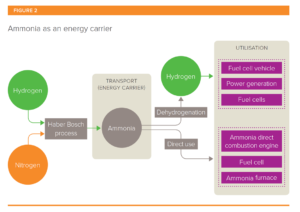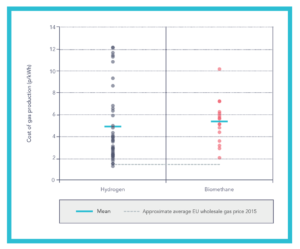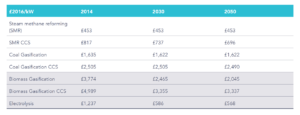Royal Society Releases Low-Carbon Hydrogen Briefing
By Stephen H. Crolius on February 23, 2018
On February 8, the Royal Society released a policy briefing entitled Options for producing low-carbon hydrogen at scale. The briefing evaluates the technical and economic aspects of hydrogen production methods and concludes that it is indeed feasible to produce low-carbon hydrogen at scale. Part of that feasibility, the briefing says, could be based on the use of ammonia as an expedient for hydrogen transport and storage.
The Royal Society is the independent scientific academy of the UK and the Commonwealth. Part of its role is to provide independent, timely and authoritative scientific advice to UK, European and international decision makers.

Professor Bill David FRS, a member of the Royal Society steering group that produced the briefing, said that the Society had focused on low-carbon hydrogen production at scale as the first step in addressing the potential transition towards a future hydrogen-based energy economy. The briefing is in part a response to the UK government’s request to assess the different technological options of large-scale hydrogen production and their economic viabilities.
The briefing’s framework for evaluation centers on “arguably the most challenging barrier to the hydrogen economy – producing hydrogen at a range of scales with little or no carbon emissions at acceptable cost.” Its scope includes production technologies in four categories: thermochemical methods, electrolysis, biological methods, and solar-to-fuel. It ultimately provides “an indication of the … readiness of each technology, the scale of cost for each and provides insights on the likely source of hydrogen at scale in coming decades.”

The briefing’s chapter on the cost of low-carbon hydrogen production includes figures taken from a July 2017 Sustainable Gas Institute (SGI) report which presents a range of estimates from previously published sources. The report shows that current low-end hydrogen cost estimates overlap with the prevailing wholesale price of natural gas in the EU.
In evaluating the potential to further enhance hydrogen’s cost competitiveness with natural gas, the Royal Society briefing draws on the SGI report and a study commissioned by the UK’s Committee on Climate Change. The briefing concludes that two technologies have the greatest near-to-mid-term potential. David commented that, “after detailed consultation on the range of options considered, only two showed long-term merit; these are the steam methane reforming [SMR] with CO2 sequestration and the use of water splitting electrolyzers.” The case for SMR rests on its position as the incumbent technology, while there are strong indications that electrolysis could experience a significant downward cost trajectory in the coming years. (The briefing also mentions that the ability of an electrolysis plant to provide grid balancing services is an additional benefit for this technology.) The prospective economics for SMR with carbon sequestration and electrolysis are the foundational elements behind the briefing’s optimism on the future of low-carbon hydrogen.

To overcome the challenges that lie in the path of hydrogen implementation, the briefing says, “a holistic consideration of the hydrogen supply chain is needed.” In this spirit, the briefing mentions ammonia as “an alternative way of transporting and storing hydrogen.”
In a short case study that builds on this theme, the briefing characterizes ammonia’s potential as follows:
Ammonia is a versatile fuel that can be used directly in high-temperature solid oxide fuel cells, cracked for low-temperature fuel cells, and partially cracked for combustion in turbines and internal combustion engines. [It] can be considered as a promising long-term hydrogen transport and storage option.
Royal Society, Options for producing low-carbon ammonia at scale, January 2018
The briefing also mentions that “the Royal Society is exploring further the science of ammonia as an energy storage system” which David will coordinate. Preliminary plans for this green ammonia briefing are in place and it is intended that the document will be published later this year.